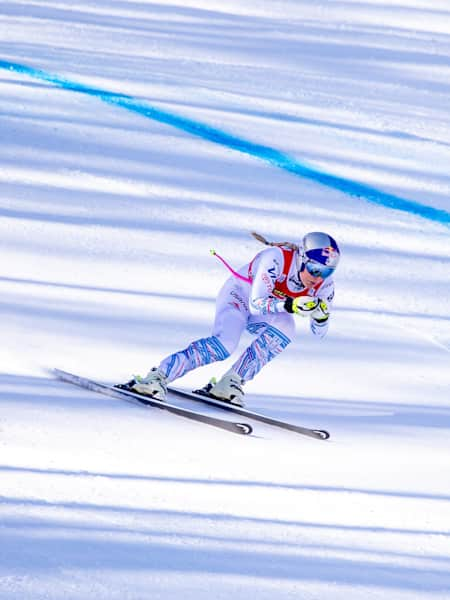For every skier, some days gliding across the snow are better than others. Red Bull freestyle skier Mac Forehand looks at it differently, though. His philosophy is to always look on the bright side.
“I am most proud of sticking with my main motto of having fun on the hill no matter the circumstances,” he says.
Of course, you can also have fun on two skis when you’re not on a hill. In fact, the world of skiing includes multiple disciplines that take you across a range of snow-filled settings. Below you’ll find a deep dive into the two most common skiing disciplines. Read ahead for a full guide to Alpine vs. Nordic skiing so you can decide which one is right for you.
01
Alpine skiing
If you’re planning to hit the slopes, you’ll be spending the day Alpine skiing. It’s essentially downhill skiing — you’ll power down a steep incline, usually on a specially groomed mountain or hillside at a ski resort.

Naturally, the force of gravity does a lot of the work for you when it comes to picking up momentum in Alpine skiing. You still need a good amount of skill and upper body strength, though, to navigate twists and turns at high speeds.
Gear and equipment for Alpine skiing are designed to ensure you make it safely to the bottom of the slope. Alpine ski boots prevent heel movement and are attached to the skis with ultra-secure bindings. The skis themselves often feature metal edges. This helps you navigate turns and obstacles, such as the slush and bumps in Bobby Brown’s Red Bull Cascade course. And, of course, you always want to wear a helmet when Alpine skiing.
02
Nordic skiing
The main difference between Alpine and Nordic skiing is the ski area. Where Alpine skiing sends you downhill, Nordic skiing involves venturing across mostly even terrain. The earth on a Nordic ski trail may feature some slight rolling ground, but it won’t be a full incline.

You need to be in tip-top shape to endure the long-distance challenge that comes with this style of skiing. For instance, at the International Ski & Snowboard Federation (FIS) World Cup, the lengthiest cross-country race is 50 kilometers, or just over 30 miles.
This brings up another point: The term “Nordic skiing” is often used synonymously with the term “cross-country skiing.” There are some nuances in Nordic vs. cross-country skiing, as there are multiple types of Nordic skiing beyond traditional cross-country. This includes skate skiing, which is almost like ice skating without the rink, where you propel forward by moving side to side. Overall, though, it’s still accurate to say that classic Nordic skiing and cross-country are the same.
In Nordic skiing, your muscles are the sole driving force since gravity doesn’t give you an extra hand. Nordic skiing equipment is designed to help you plow through the countryside in a kick-glide motion with as little hindrance as possible. For example, Nordic ski boots and bindings are designed to give you more heel movement. You’ll also use your ski poles for leverage as you move across the snow.
03
Alpine vs. Nordic skiing: key differences
Beyond the terrain and type of equipment you use, there are notable distinctions between Alpine and Nordic skiing.
- Skill requirements. It’s not about which style is easier but which style suits your personal strengths. Nordic skiing takes a lot of stamina, while alpine requires instant reaction time.
- Fitness training. Your muscles need to be strong with either type of skiing, but how you get to this point differs. If you’re trying to prepare for Alpine skiing, workouts that emphasize short intense bursts are key. For Nordic skiing, you want an exercise regimen that focuses on steady pacing for long time periods.
- Safety considerations. Protective equipment is especially important for preventing accidents when you’re gliding down the snow at high speeds on an Alpine slope. If you’re spending a full day on a Nordic trail, you’ll need to make sure you stay hydrated and well-fueled for the long journey.
04
Choosing the right skiing style
Nordic and Alpine skiing both offer a lovely day outside in a winter wonderland. If you want to experience snow-covered nature, ask yourself: Do you want this as a moderately-paced hike or at high-flying speeds?
One style challenges your resilience, while the other will serve you a huge dose of adrenaline. There’s no wrong choice between the two, plus you can eventually combine them via alpine touring. You’ll both glide downhill and use the muscles you’ve built up for cross-country skiing, testing your endurance while meeting your need for speed.
05
Alpine vs Nordic skiing: tips for beginners
If you’re just getting started, here’s some advice to set you up for success before you fasten those ski boots.
- Etiquette. Respecting the right of way with those you’re skiing with is essential whether you’re on the slopes or a Nordic trail. In a downhill setting, anyone ahead of you has the right of way, and the onus is on you to give them space. Anyone traveling downhill will be looking ahead and won’t know what line you’re skiing in. With Nordic skiing, the important thing is to only go in the direction indicated by your line. If faster skaters are coming up behind you, move to the side.
- Stance. Good form is essential to both styles of skiing. On a Nordic trail, keep your feet shoulder-width apart with your arms in front for stability. You’ll have your feet hip-width apart in Alpine skiing, with your head, shoulders, and hands pointed downhill.
- Fueling up. No matter which style you’re trying out for the first time, you’ll need plenty of energy for the day ahead. Eat a well-balanced meal with carbs and protein one or two hours before you head out. Pack high-energy snacks for when you need to refuel.
Alpine vs. Nordic: choose your own adventure
In the world of cross-country vs. downhill skiing, there’s no wrong answer — it’s about figuring out which style plays to your own strengths and preferences. Plus, you don’t have to stick to just one style. Test your endurance on a cross-country trail one weekend, then head to a resort and blaze down a mountainside the next. No matter how you choose to ski, adventure awaits.







